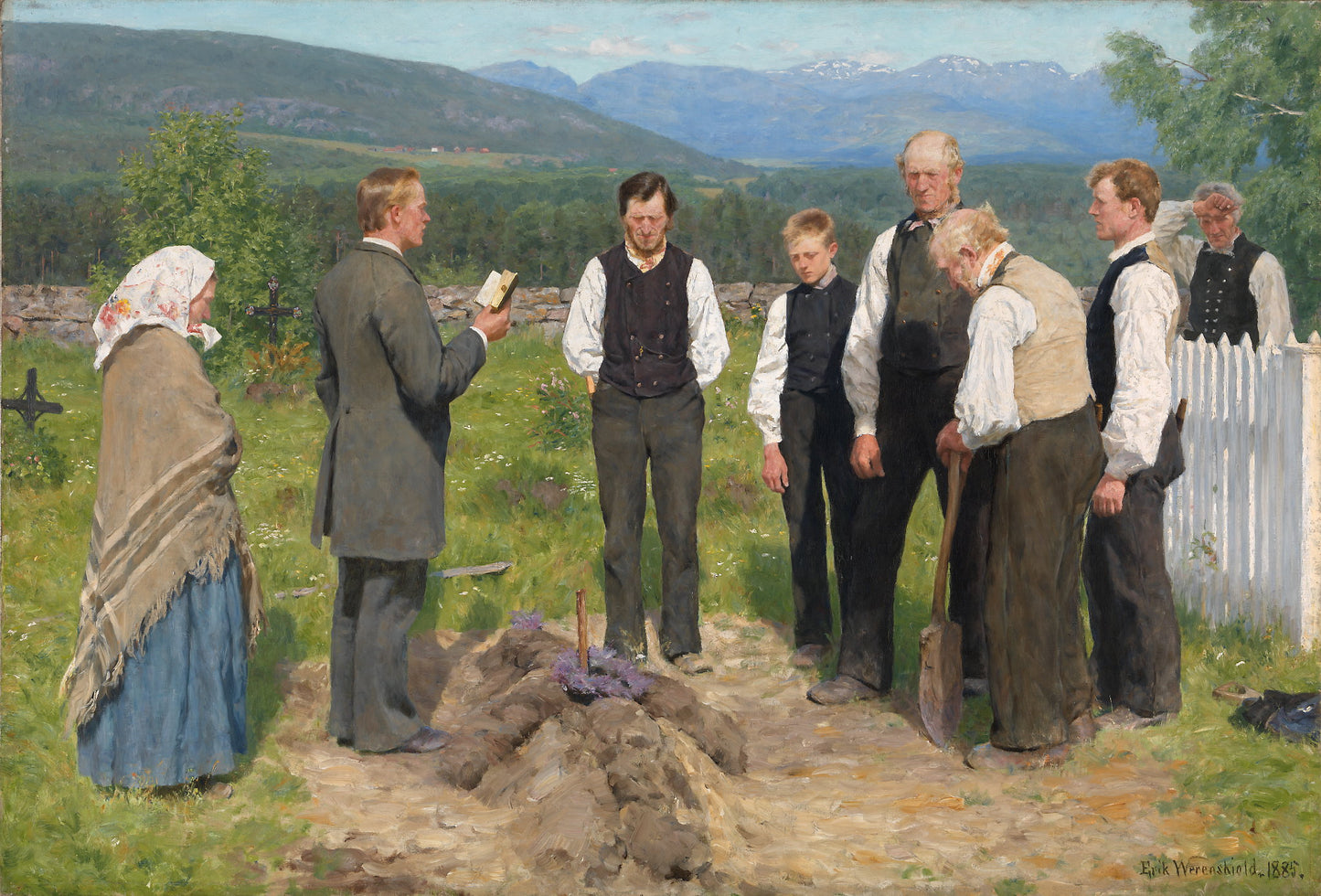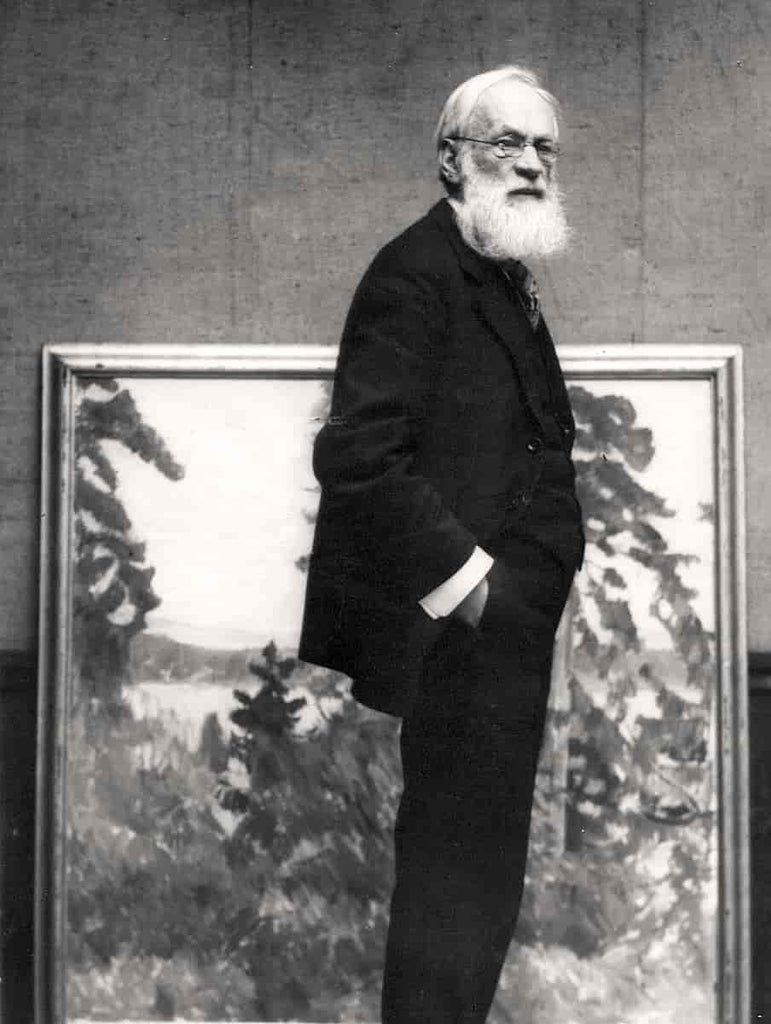Erik Werenskiold
A peasant funeral
A peasant funeral
Couldn't load pickup availability
High-quality reproductions from the National Museum's collection. Posters by DAIDDA are printed on Litho White Matt - 230 gram photo paper in premium quality. Artprints by DAIDDA provide outstanding colors, sharpness and durability in museum quality - printed on Moab Entrada Natural 300 gram cotton art paper. Printed on a matte surface with scratch-resistant pigment ink.
About the original:
Erik Werenskiold made a strong impact in Norwegian art and cultural history from the end of the 1870s until well into the next century. First as an adventure artist and naturalist. Later as a leading figure in the nationally oriented Lysaker circle.
Ever since the painting was first exhibited at the Autumn Exhibition in 1885, A Farmer's Funeral has been perceived as a major work in Norwegian art. It caused great excitement and was acquired for the National Gallery in the same autumn.
Werenskiold found the motif on a study trip in Gudbrandsdalen a few years before, while the painting itself was carried out over three summers at Gvarv in Telemark. It is likely that it was mostly done outdoors, since it was done with the fresh light and colors of plein air painting. The emphasis on direct outdoor study was an important part of the naturalists' program, where truth challenged beauty as an ideal in art. The picture raises several questions. Who is the dead one? Why is there only one woman? Who is the man with the book? And why is there a stick in the dirt pile? The picture deals with a funeral where a school teacher or bells stand in place of the priest. In the village it happened that you had to perform preliminary rituals. A stick was put in the grave so that the priest could later come and carry out the burial.
It's summer, the sun is shining and it's hot. The rendering is clear and lifelike. At the same time, the picture offers a wide range of painterly means, from the finely brushed landscape in the background to the grave, which is drawn up with rough, sweeping strokes.
Text: Øystein Ustvedt
Dating: 1883-1885
Other titles: Peasant Burial (ENG)
Designation: Painting
Material and technique: Oil on canvas
Technique: Oil
Material: Canvas
Dimensions: 102.5 x 150.5 cm
Subject: Visual arts
Classification: 532 - Visual arts
Acquisition: Purchased 1885
Inventory no.: NG.M.00320
Part of exhibition: Art 3. Works from the collection 1814-1950, 2007 - 2011
Erik Werenskiold (1855-1938), 2011
The dance of life. The collection from antiquity to 1950, 2011 - 2019
The 1880s in Nordic painting, 1985 - 1986
The 1880s in Nordic painting, 1986
Edvard Munch. The sick child. The Story of a Masterpiece, 2009
The 1880s in Nordic painting, 1986
The 1880s in Nordic painting, 1985
Registration level: Single object
Owner and collection: The National Museum of Art, Architecture and Design, Visual Art Collections
Photo: Høstland, Børre
Shipping and returns
Shipping and returns
Shipping: We deliver to Scandinavia, the EU, the USA and several other countries. Please contact us if your country is not listed and we will try to arrange delivery.
Delivery time: 2-5 days within Norway, 7 days in Europe, 14 days globally.
Packaging: Our products are made to order and sent rolled in environmentally friendly packaging.
Customs Fees: International orders may be subject to customs fees, which are not included in shipping costs.
Return policy: You can return images within 14 days. See our returns page for more information.
Secure Payment: We never store your payment details. See our privacy policy for details.

See all works
-
"Huttetu! here smells so Christian man's blood," said the troll
Vendor:Erik WerenskioldRegular price From 150,00 NOKRegular priceUnit price per -
Then they both laughed heartily
Vendor:Erik WerenskioldRegular price From 150,00 NOKRegular priceUnit price per

Erik Werenskiold
Erik Werenskiold was a Norwegian painter and draftsman known for his naturalistic and nationally oriented paintings of folk life in the 1880s. He is also known for the illustrations for Norwegian folk tales by Asbjørnsen and Moe and for Snorre's royal sagas. In 1905 he changed his style to a formally simplified and decorative style inspired by Paul Cézanne. Werenskiold was born in Eidskog and grew up in Kongsvinger.
He first studied under Julius Middelthun at the Art School in 1873 and later under Wilhelm Lindenschmit in Munich from 1876 to 1877. Werenskiold became convinced of the superiority of French plein air painting after seeing an exhibition by Charles François Daubigny in Munich in 1879. This led to the colors i Werenskiold's pictures became brighter, and he began to move towards naturalism. Werenskiold traveled to Paris in 1881 to study French naturalistic art more closely and traveled there annually until 1885. Werenskiold spent time in Norway, especially in Telemark, when he was not in Paris. It was here that he created his modern, realistic paintings of folk life and depicted children and people in the open air.
He was seen as an innovator of national painting through his depictions of Norwegian folk types and nature in Telemark. Werenskiold was also a skilled portrait painter and painted many characteristic portraits of famous Norwegians, including Bjørnstjerne Bjørnson, Edvard Grieg and Henrik Ibsen. Werenskiold was one of the most significant Norwegian artists of his time and has had a great influence on Norwegian art.





